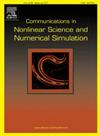非齐次随机通信协议模糊系统的滑模控制
IF 3.4
2区 数学
Q1 MATHEMATICS, APPLIED
Communications in Nonlinear Science and Numerical Simulation
Pub Date : 2025-04-29
DOI:10.1016/j.cnsns.2025.108701
引用次数: 0
摘要
本研究系统地研究了由Takagi-Sugeno (T-S)模型建模的非线性系统的输出反馈滑模控制(SMC),并结合了随机通信协议(SCP)。为了提高通信效率和可靠性,提出了一种基于非均匀驻留概率信息的传输概率决定传感器节点选择的SCP算法。与现有的齐次逗留概率不同,非齐次逗留概率具有多面体结构集的特征,其变化由上层确定性切换控制。为了解决观测系统状态的挑战,设计了基于调度信号的输出反馈SMC,以克服不可观测系统状态带来的限制,并减轻SCP影响。在此基础上,设计了保证T-S模糊系统随机稳定和滑模函数可达性的充分条件。最后,以小车阻尼弹簧模型和隧道二极管电路模型为例,验证了本文方法的有效性和优越性。本文章由计算机程序翻译,如有差异,请以英文原文为准。
Sliding mode control for fuzzy systems with nonhomogeneous stochastic communication protocol
This study systematically investigates output-feedback sliding mode control (SMC) for nonlinear systems modeled by the Takagi–Sugeno (T-S) model, incorporating a stochastic communication protocol (SCP). To enhance communication efficiency and reliability, a novel SCP is proposed, which determines sensor node selection, with transmission probabilities derived from nonhomogeneous sojourn probability information. Unlike existing homogeneous sojourn probabilities, nonhomogeneous sojourn probabilities are characterized by a polytope-structured set, where variations are governed by upper-level deterministic switching. Addressing the challenge of observing system states, a scheduling-signal-based output feedback SMC is designed to overcome limitations imposed by unobservable system states and mitigate SCP impacts. Based on this, sufficient conditions are devised to ensure stochastic stability of T-S fuzzy systems and attain sliding function reachability. Finally, the cart-damper-spring model and the tunnel diode circuit model are presented as two practical examples to validate the effectiveness and superiority of our developed methodology.
求助全文
通过发布文献求助,成功后即可免费获取论文全文。
去求助
来源期刊

Communications in Nonlinear Science and Numerical Simulation
MATHEMATICS, APPLIED-MATHEMATICS, INTERDISCIPLINARY APPLICATIONS
CiteScore
6.80
自引率
7.70%
发文量
378
审稿时长
78 days
期刊介绍:
The journal publishes original research findings on experimental observation, mathematical modeling, theoretical analysis and numerical simulation, for more accurate description, better prediction or novel application, of nonlinear phenomena in science and engineering. It offers a venue for researchers to make rapid exchange of ideas and techniques in nonlinear science and complexity.
The submission of manuscripts with cross-disciplinary approaches in nonlinear science and complexity is particularly encouraged.
Topics of interest:
Nonlinear differential or delay equations, Lie group analysis and asymptotic methods, Discontinuous systems, Fractals, Fractional calculus and dynamics, Nonlinear effects in quantum mechanics, Nonlinear stochastic processes, Experimental nonlinear science, Time-series and signal analysis, Computational methods and simulations in nonlinear science and engineering, Control of dynamical systems, Synchronization, Lyapunov analysis, High-dimensional chaos and turbulence, Chaos in Hamiltonian systems, Integrable systems and solitons, Collective behavior in many-body systems, Biological physics and networks, Nonlinear mechanical systems, Complex systems and complexity.
No length limitation for contributions is set, but only concisely written manuscripts are published. Brief papers are published on the basis of Rapid Communications. Discussions of previously published papers are welcome.
 求助内容:
求助内容: 应助结果提醒方式:
应助结果提醒方式:


